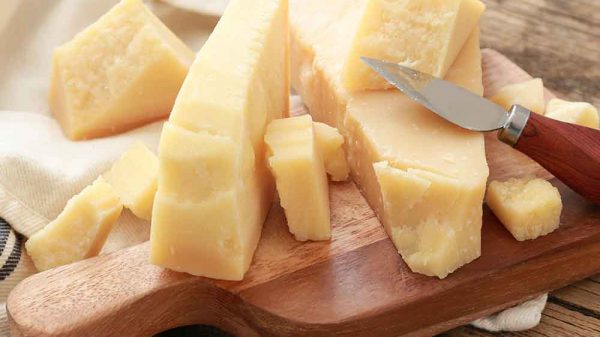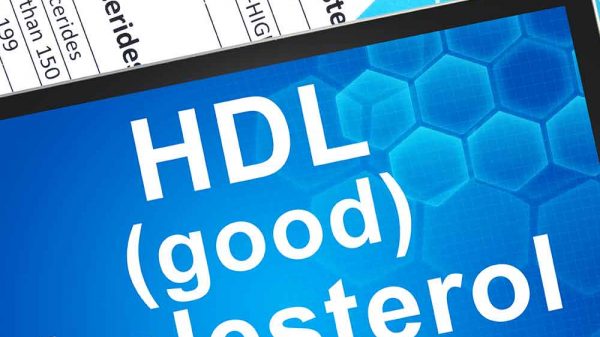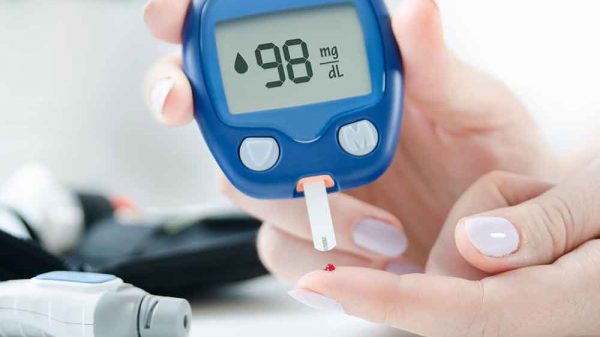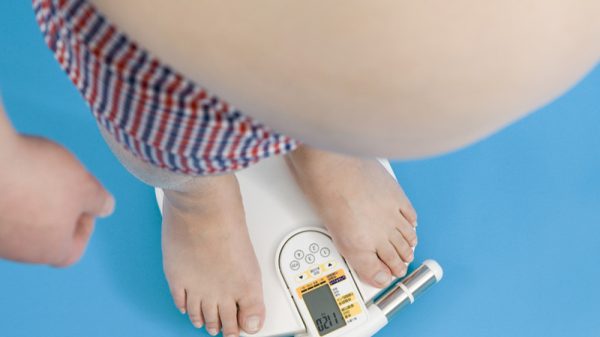We’ve heard a lot about salt raising blood pressure and the importance of limiting salt intake to maintain good cardiovascular health. But does sugar raise blood pressure? Keep reading to find out how sugar impacts blood pressure and the importance of limiting sugar in your diet.
Sugar Contributes to Risk Factors for High Blood Pressure
High blood pressure, or hypertension, means that the blood in our blood vessels is exerting excessive force on arterial walls. Blood pressure is measured by two numbers, the first being systolic pressure, which describes the pressure as the heart contracts to circulate blood throughout the body. The second measurement, diastolic pressure, describes the pressure in blood vessels between heartbeats. In general, the systolic pressure measurement tends to be higher than the diastolic pressure measurement.
High blood pressure is associated with metabolic syndrome and heart disease. Added sugar is a well-known culprit in causing a host of metabolic conditions including obesity, insulin resistance, and fatty liver disease.
How Does Sugar Contribute to Metabolic Syndrome?
Sugary beverages and processed foods that contain lots of added sugar that are immediately broken down by the digestive system, entering the bloodstream in high amounts. This causes a spike in blood sugar levels. Lots of glucose is coursing through the blood vessels and in response, the pancreas releases insulin that signals to body tissues to use available glucose to power cellular processes. Though some glucose is vital for survival and normal energy levels, excess glucose causes inflammation and is stored as fat throughout the body and in the liver.
Over time, chronic consumption of excess glucose can cause inflammation that damages the pancreas and makes insulin unresponsive to glucose in the bloodstream. This results in hallmarks of metabolic syndrome, including insulin resistance and type 2 diabetes.
Added Sugar Intake Increases Blood Pressure
It’s becoming common knowledge that added sugar plays a causal role in chronic diseases like insulin resistance, weight gain, and type 2 diabetes. What few people realize is that, just like high salt intake, high sugar intake directly contributes to high blood pressure. So, eating excess sugar is a significant and direct causal factor for both diabetes and hypertension.
The mechanism for sodium-induced high blood pressure and sugar-induced high blood pressure differ. Salt increases blood pressure by causing you to retain water, which increases blood volume and increases the pressure exerted on vessel walls.
Research published in Open Heart and conducted by researchers at Saint Luke’s Mid America Heart Institute in Missouri and Albert Einstein College of Medicine in New York examines the impact of added sugar on cardiovascular health. Results showed that added sugars negatively impact blood pressure by increasing inflammation, increasing salt retention, and decreasing nitric oxide. Consuming too much sugar also activates the nervous system and increases heart rate. (1)
The impact of sugar on nitric oxide – a powerful vasodilator in the body – is particularly compelling. Nitric oxide is a critical molecule for the healthy functioning of the endothelium, the lining of cells that control constriction or dilation of blood vessels. (2)
Vasoconstriction means that blood vessels narrow, increasing the pressure that blood exerts on arterial walls. Vasodilation means that blood vessels widen, increasing blood flow while decreasing blood pressure. High levels of glucose have been shown to decrease nitric oxide production, which may result in rigidity in the endothelium, which contributes to higher blood pressure. (3)
Aside from Salt and Sugar, What Raises Blood Pressure?
In addition to high-salt and high-sugar products, foods that raise blood pressure include those that are high in saturated fat. Foods high in saturated fat can contribute to weight gain and metabolic syndrome while raising your risk of hypertension too.
Not eating enough potassium contributes to high blood pressure. Adequate potassium intake promotes electrolyte balance in the blood and helps counteract the effects of sodium.
Leading a sedentary lifestyle can raise your risk of developing hypertension. Without sufficient activity and exercise, the heart does not grow stronger as a muscle. As a result, the heart must work much harder to pump blood throughout the body, which causes blood flow to exert more pressure on arterial walls.
Complications of High Blood Pressure
The ultimate outcome of chronic high blood pressure, regardless of the cause, is the same. If left unchecked, high blood pressure damages blood vessels. Blood vessels develop scar tissue and harden in response to continuous hypertension-induced injury. Hypertension combined with concurrent metabolic conditions like high cholesterol increases the risk of atherosclerosis, which is the formation of plaques in the artery. Damaged and blocked blood vessels may restrict blood flow to certain parts of the body, leading to tissue damage. In particular, high blood pressure significantly contributes to the development of heart disease and the likelihood of experiencing a heart attack, stroke, or heart failure.
Luckily, many things can be done to reverse high blood pressure and prevent life-threatening complications. Your physician may decide to prescribe blood pressure medication to help control hypertension. In addition to medication, healthy diet guidelines and lifestyle changes can help you remove added sugars from your diet and lower blood pressure.
How to Avoid Added Sugars and Improve Your Blood Pressure
Avoiding added sugars is the key to limiting sugar intake in your diet. Dietary guidelines from the American Heart Association recommend that for men, 36 grams of added sugar is the daily maximum and for women, 25 grams is the daily maximum. (4) Less is always better though, so aim to consume as little added sugar as possible. Knowing where added sugars are hiding is important for making the best food choices for a low-sugar diet. Follow these tips for cutting down on the amount of added sugar in your diet.
1. Avoid Packaged Foods and Soft Drinks
A good rule of thumb for avoiding added sugar is to avoid all packaged or processed foods. Packaged foods are manufactured and filled with added sugar to improve the taste. Packaged foods to avoid include cookies, crackers, cakes, cereals, and many granola bars and snack food items.
Plus, by avoiding packaged foods in general, you’ll also be avoiding other harmful ingredients like trans fats, saturated fats, excess salt, and preservatives that contribute to inflammation, metabolic syndrome, and fatty liver disease.
Soft drinks and other sweetened drinks are a major contributing factor when it comes to sugar consumption. It’s easy to down a can of soda in just a few minutes, which could contain 40 grams of sugar or more. Soft drinks aren’t the only problem, however. Fruit juice, sports drinks, sweet tea, and sweetened coffee drinks all contain massive amounts of sugar that contribute to metabolic syndrome and high blood pressure.
2. Read Food Labels
When you do eat packaged or processed foods, labels are an indispensable resource when it comes to determining how much added sugar is in a product. When reading food labels, be sure to look at both the nutrition facts and the ingredients list. The nutrition facts will tell you how many grams of sugar are present in the food item.
Unfortunately, most nutrition labels don’t provide a distinction between added sugars and naturally-occurring sugars. You can determine whether sugar has been added to a product by reading the ingredients list. Look out for words like syrup, including high-fructose corn syrup and brown rice syrup. Other words to look out for include fructose, sucrose, dextrose, and maltose. Sometimes, ingredients may list sugar as “coconut sugar” or “date sugar.” Don’t be fooled by these ingredients. Even though the sugar may have originated from a plant, it’s still been processed and removed from the original fruit and added to another product, classifying it as added sugar.
Even if a product seems like it wouldn’t contain any added sugars, read the labels just to make sure. Some products are marketed with health-food phrases, such as “whole-grain” and “natural” that may be hiding added sugars. Many canned items may contain added sugar, such as canned corn and fruit. Look out for salad dressings, pasta sauces, and other sauces that also may contain added sugar to enhance flavor.
3. Avoid Refined Carbohydrates
Refined carbs are another hidden source of sugar that can sometimes be tricky to pinpoint. Though not technically an added sugar, the carbs in these foods are handled by the body in much the same way as added sugars. These carbs have undergone a manufacturing process to remove all nutritional value like fiber, protein, minerals, and antioxidants. The end product is a refined starchy carbohydrate that can be rapidly broken down by the digestive system and sent into the bloodstream in the form of glucose. Avoid foods like white bread, white pasta, white rice, and refined white potato products like potato chips and fries. Instead, opt for whole-grain bread, whole-grain pasta, and brown rice, as long as they don’t contain any added sugars.
4. Avoid Baked Goods
We all love a fresh-baked pastry or doughnut from the local bakeshop. However, these items are loaded with sugar and shortening, and often don’t come with a nutrition label. When eating one of these tasty items, there’s really no way to know how many grams of sugar you are consuming. Reserve cakes, cookies, and other pastries for special occasions.
5. Make Good Choices at Restaurants
Limiting sugar in your diet doesn’t mean you always need to avoid restaurants – you just have to be prepared with strategies for avoiding the main sugar sources in restaurants. When ordering anything, ask if it’s possible to serve with the sauce or dressing on the side and use sparingly.
Many sauces – even if they’re homemade – are filled with added sugar. For example, just a couple of tablespoons of barbeque sauce may contain 10 or even 15 grams of sugar! Additionally, go easy on condiments like ketchup, which usually contains several grams of sugar per tablespoon.
6. Swap Out Added Sugars for Nitrate-Rich Vegetables
In addition to cutting sugar out of your diet, you can add foods that support endothelial function. Natural nitrates are found in many vegetables like beets, spinach, broccoli, arugula, tomato, and mustard greens. (5)
The body can convert nitrates from vegetables into biologically relevant nitric oxide, which helps aid vasodilation.
On the other hand, avoid nitrites and nitrates that are added to meats as preservatives. Though these added compounds play a role in keeping meat fresh, they interact with meat proteins during the cooking process that leads to the formation of carcinogenic nitrosamines.
7. Add High-Quality Protein to Your Diet
Research shows that diets that include more protein tend to be associated with lower blood pressure. At the same time, plant protein seems to have a more positive effect on blood pressure than animal protein. (6)
If you’re planning to rely on plants as your protein source, make sure you’re eating a variety of foods like whole grains, beans, and nuts. Plant protein sources contain essential amino acids, but most do not contain all essential amino acids that we require from food. Therefore, it’s important to eat a variety of plant food to obtain all essential amino acids. Tofu, tempeh, and soybeans are the exceptions and contain all essential amino acids in optimal ratios. Getting a balance of all essential amino acids is vital for supporting all bodily functions, including liver function, metabolic health, and muscle growth.
Animal protein sources have a complete profile of essential amino acids. If you choose animal products for protein, make sure you’re choosing high-quality animal protein sources that are unprocessed and low in saturated fat. Good examples of high-quality animal protein sources include nonfat dairy products, fish, chicken breast, and whey protein.
8. Add Antioxidant-Rich Foods to Your Diet
Research suggests that high amounts of glucose cause oxidative stress that inhibits healthy endothelial function, and that antioxidants may help counteract this effect. (7)
Oxidative stress occurs when your cells are exposed to harmful conditions, such as excess glucose. Waste products build up in cells, and the body has a difficult time trying to clear waste from the system. This results in less efficient cellular processes. The body is unable to effectively lower blood pressure, clear glucose from the system, and repair damage in liver cells or the cardiovascular system.
Antioxidant-rich foods counteract all of the effects of oxidative stress. As an added benefit, antioxidant-rich foods like fruits and vegetables tend to be rich sources of potassium. Potassium is a mineral that counteracts the effects of sodium to promote lower blood pressure levels. Particularly rich sources of potassium include avocados, bananas, broccoli, sweet potato, and spinach.
9. Follow the DASH Diet
The Dietary Approaches to Stop Hypertension (DASH) diet is recommended by physicians, the American Heart Association, and the National Heart, Lung, and Blood Institute for improving hypertension and metabolic syndrome. (8)
The DASH diet is based on eating lots of whole foods like vegetables, fruits, whole grains, nuts, beans, nonfat and low-fat dairy, and fish while limiting processed foods, salt, sugar, and saturated fat.
The diet has long been shown to have therapeutic effects on blood pressure and cardiovascular disease risk. A review published in Nutrients found that the DASH diet helped improve hypertension as well as many markers of metabolic syndrome, like insulin resistance and cholesterol levels. (9) Another meta-analysis published in Medicine examined numerous studies and found that adherence to the DASH diet significantly reduced the risk of stroke. (10)
10. Exercise
Adding consistent exercise to your routine is critical for lowering blood pressure. Aerobic exercise is important for strengthening your cardiovascular system, particularly the heart. By building up cardiovascular endurance, your heart will become more efficient and it won’t need to work as hard to pump blood throughout the body. In turn, the force of blood flow against arterial walls will decrease, effectively decreasing both systolic and diastolic blood pressure.
DASH Diet Meal Ideas for Hypertension
Here are a few examples of the DASH diet-friendly meals that help promote low blood sugar and low blood pressure:
- Breakfast: For a DASH diet breakfast, try making quinoa porridge! It’s basically a heartier version of oatmeal, with more high-quality protein and essential amino acids. Add cinnamon, sliced banana, raisins, and plant-based milk to hot, cooked quinoa. Top with a generous dollop of low-fat, low-sugar Greek yogurt. Serve with a side of brewed coffee and unsweetened almond milk for a liver-friendly, low-sugar beverage.
- Lunch: Make a salad bowl with a serving of whole-grain buckwheat pasta, soybeans, and sliced red pepper, carrots, cucumber, basil, and any other fresh vegetables and herbs of your choice for a powerful punch of antioxidants. Drizzle with a low-sodium, low-sugar peanut sauce or dressing of your choice.
- Dinner: For an anti-inflammatory dinner that promotes low blood pressure, try oven-baked salmon for healthy fats and optimal ratios of essential amino acids. Be sure to use a marinade that’s low in salt and sugar. Serve with loads of veggies on the side by topping a bed of lettuce with chopped beets, roasted asparagus, and steamed broccoli, and drizzle with balsamic vinaigrette.
Keep in Mind That Not All Sugar Raises Blood Pressure
Keep in mind that natural sugar that comes from fruit is healthy when consumed as part of the whole fruit. Sugar in fresh fruit is combined with loads of fiber, vitamins, minerals, and antioxidants that support healthy blood pressure levels and metabolic functioning. The sugar in whole fruits is digested slowly due to the high fiber content, supplying your body with a steady stream of fuel without blood sugar spikes.
The problem with fruit sugar comes when it is isolated from the whole fruit and added to processed ingredients. So, when avoiding sugar to benefit blood pressure, make sure to watch out for added sugars! But feel free to consume fresh fruit in abundance.
Conclusion
Sodium is often blamed as the main contributing agent for high blood pressure, while the detriments of sugar are thought to be confined mainly to insulin resistance and diabetes. However, it turns out that added sugar can be just as detrimental for diabetes and hypertension. Cutting out sugar, eating a balanced ratio of essential amino acids, and following the DASH diet are significant parts of a healthy lifestyle that help you lower blood pressure.
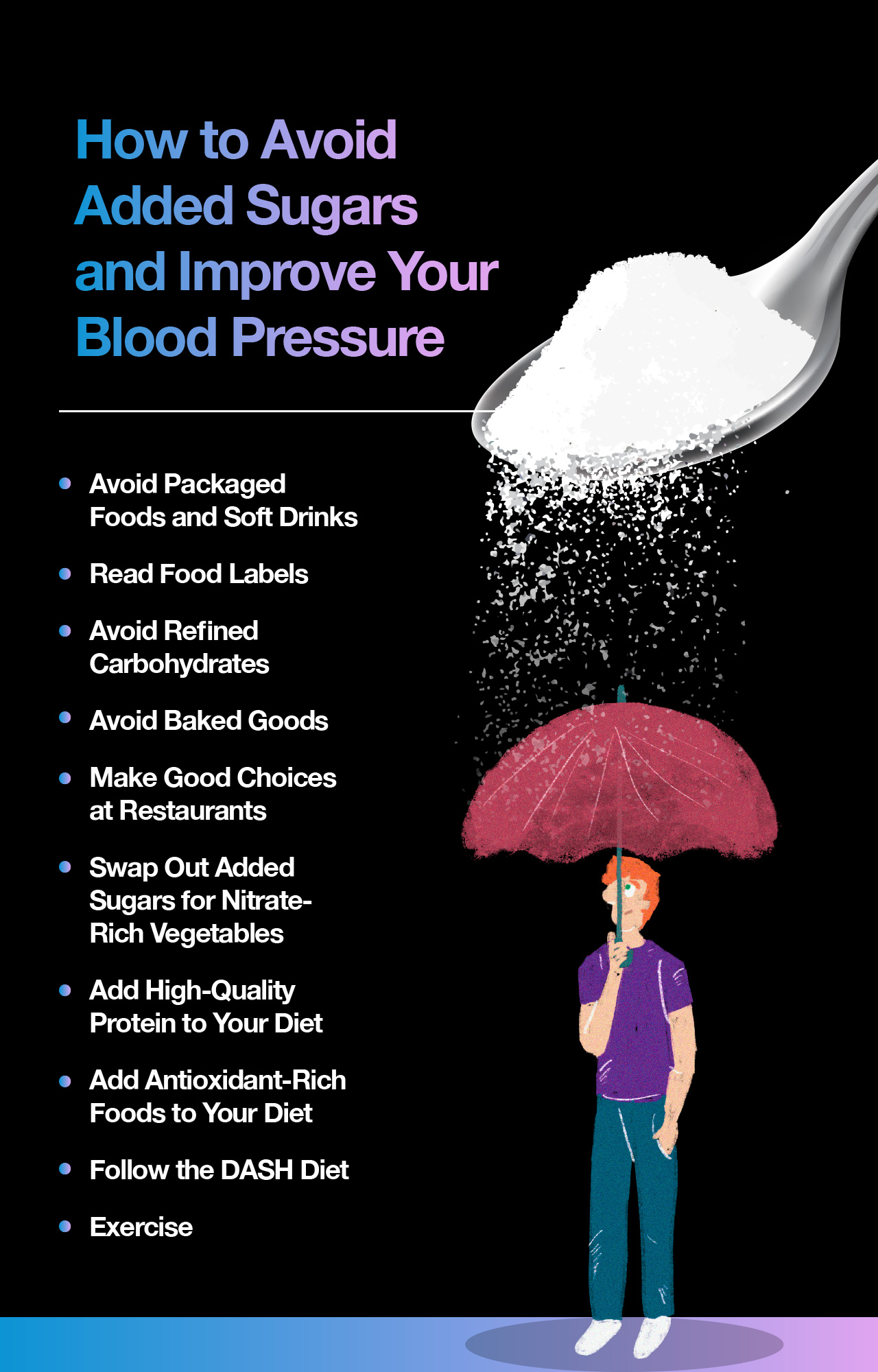
References:
(1) https://www.ncbi.nlm.nih.gov/pmc/articles/PMC4336865/
(2) https://www.ncbi.nlm.nih.gov/pubmed/19439460
(3) https://www.ncbi.nlm.nih.gov/pubmed/14610325
(4) https://www.heart.org/en/healthy-living/healthy-eating/eat-smart/sugar/how-much-sugar-is-too-much
(5) https://www.ncbi.nlm.nih.gov/pubmed/19439460
(6) https://www.ncbi.nlm.nih.gov/pubmed/12544662
(7) https://www.ncbi.nlm.nih.gov/pubmed/28408372
(8) https://www.nhlbi.nih.gov/health-topics/dash-eating-plan
